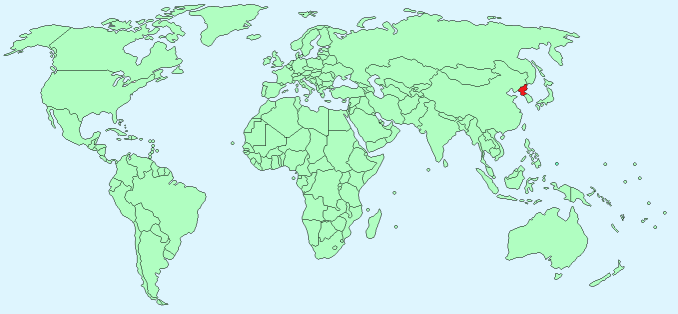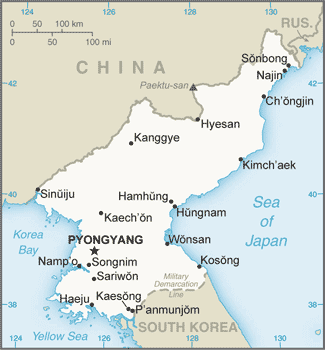North Korea


Continent – Asia
Region – Eastern Asia
Size – 120,538 km²
Geography – mountains and hills with valleys and coastal plains
Language – Korean
Religion – None
Monetary Unit – North Korean won
Natural Resources – coal, lead, tungsten, zinc, graphite, magnesite, iron ore, copper, gold, pyrites, salt, fluorspar, hydropower
Agriculture – rice, corn, potatoes, soybeans, pulses; cattle, pigs, pork, eggs
Industry – military products; machine building, electric power, chemicals; mining (coal, iron ore, limestone, magnesite, graphite, copper, zinc, lead, and precious metals), metallurgy; textiles, food processing; tourism

Neighbouring Countries – China, Russia, South Korea
Population – 24,851,627 (2014 estimate)
Population Growth Rate – 0.53%
Average Life Expectancy – 69.8
Capital City – Pyongyang (2,843,000)
Highest Mountain – Paektu-san (2,744m)
Longest River – Yalu (790 km)
Climate – continental – cold winters -17°C to -8°C and warm summers 18°C to 28°C
Yearly Rainfall – 90 cm (approx) mostly from June to September
Plant Life – firs, spruces, evergreen trees, alpine plants
Animal Life – Siberian tiger, bears, wild boar, deer, snow leopards, lynx, roe deer, shrew
Bird Life – black Manchurian ring-necked pheasant, black grouse, and three-toed woodpecker; the hawk owl, lesser-spotted woodpecker and willow tit
Harvard Reference for this page:
Heather Y Wheeler. (2015). North Korea. Available: https://www.naturalhistoryonthenet.com/Facts_Figures/Country_Facts/north_korea.htm. Last accessed Monday, July 18, 2016
Facts and Figures Pages
